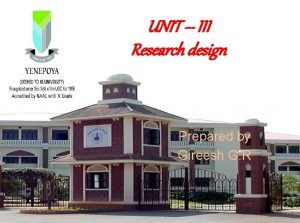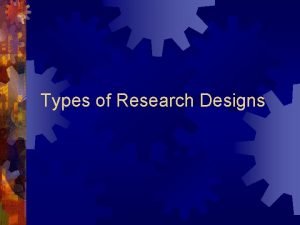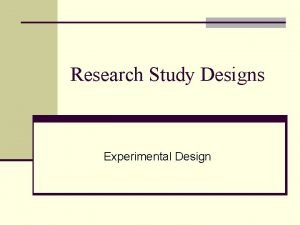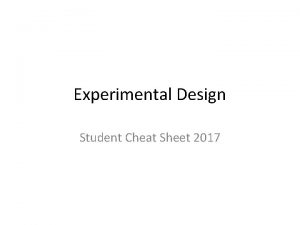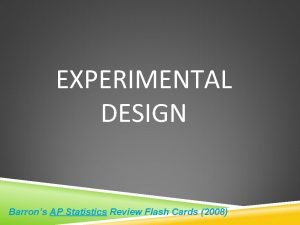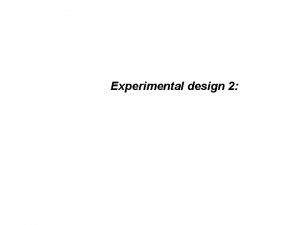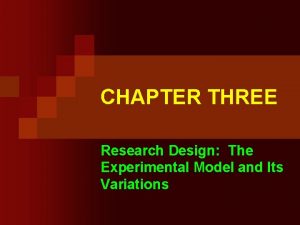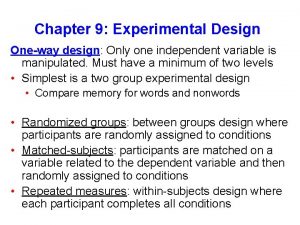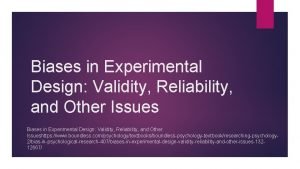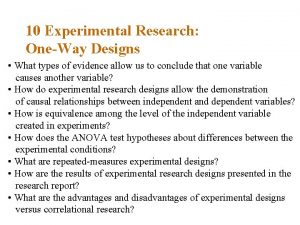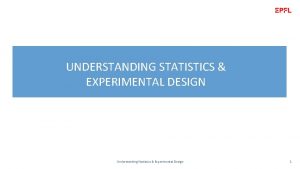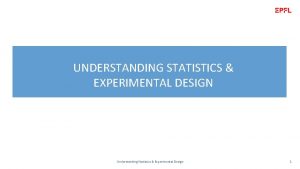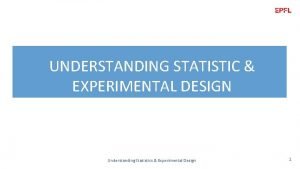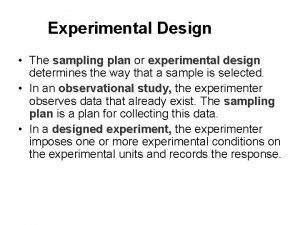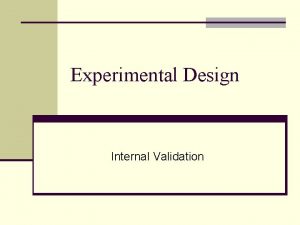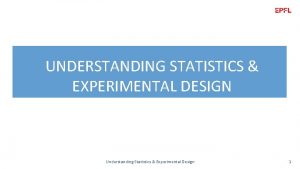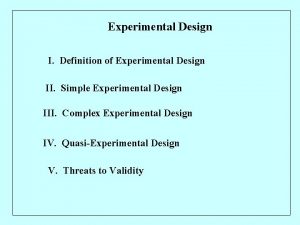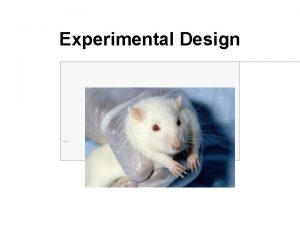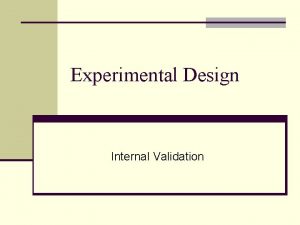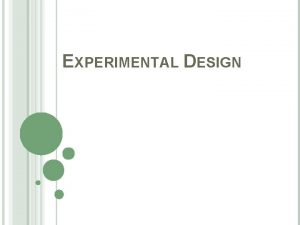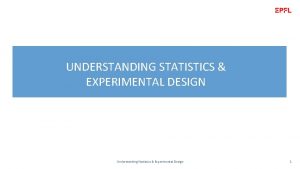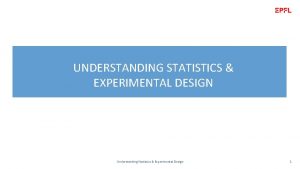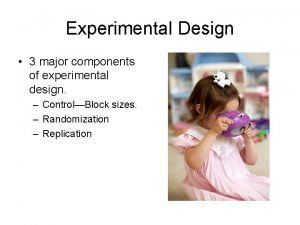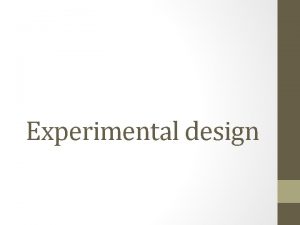Experimental Design Experimental Design Introduction It is a
































- Slides: 32

Experimental Design

Experimental Design • Introduction: • It is a plan used to collect the data relevant to the problem under study in such a way as to provide the basis for valid and objective inference about the stated problem.

• The plan consists of: • 1) Selection of treatments whose effects are to be studied • 2) The specification of the experimental layout • 3) The assignment of treatments to the experimental units • 4) Collection of observation for analysis

• An experiment is planned to: • a) Get maximum information for minimum expenditure in the min. possible time • b) Avoid systematic errors. • c) Evaluate the outcomes critically and logically • d) Ignore spurious effect, if any

Following consideration used to planning of exp. : • 1) What is the exp. inteded to do? • 2) What is the nature of treatments or • • dependent variable and how are they to be estimated? 3) How is the independent variable likely to effect the treatments or dependent variables? 4) Are the factors to be held constant or varied? If varied whether the variation is quantitative or qualitative?

Analysis of experiment • The sigificance of difference between the means of 2 different samples can be tested by • Paired t-test or Z-test depending on the sample size. • If the sample size is less than 30 ----t-test • -----------more than 30 ----Z-test

• Salesman 2 factor • Time period 4 • Objective is to test the significance of difference between the mean sales reveneu t-test or ztest • If the no. of sales man or factor is n more than 2 then F-test can be used if more then 2 then a comprehensive technique Analysis of Variance ---ANOVA can be used

ANALYSIS OF VARIANCE ( ANOVA) • Decompositionng of total variability into its components is called analysis of variance

Types of factors: • A factor , which has effect on response variable • • of an exp. 1) Fixed factor: In an exp. , if a specific set of treatments of a factor is selected with certainty , then that factor is termed as fixed factor. In such case the inference of the analysis of the exp. is applied to only the set of treatments of that factor. e. g if 4 salesman A, B, C and D ---effect on sales then the inference is applied to only those 4.

2) Random Factor: • In an exp. , if a set of treatments of factors is • selected randomly from among the available treatments , then that factor is termed as random factor. Under such situation, the inference of analysis of the exp. can be generalized to all of the treatment of factor. e. g if four salesmen A, D , M and X are selected randomly from available A, B, C-----Z for studying their effect on the sales revenue

Effect of different explants sources on shoot induction • Explant No. of explant cultured Days to shoot initiation No. of t. t Shoot initiation showing result • • • Apical meristem 10 8 -9 9 Axillary meristem 10 -12 7. 2 Nodal region 10 12 -15 6. 8

• Explant = Factor =1 • Level of factor or treatments=3 • Replicate = 5 are carried out to minimize the error • Response variable =2 Days , No. of t. t • e. g. Replicate of 8 -9=10, 8, 9, 10, 9

Types of Design: • 2 types: 1) Systematic 2) Random • Analysis of variance techniques are suitable to • • • randomized design only. The basic randomized design are 1) Completely randomized design 2) Randomized complete block 3) Latin Square 4) Duncan”multiple range test 5) Factorial design

Basic Principles of Experimental Design: • 1) Randomization 2) Replication 3) Local control • 1) Randomization: It is a random process assigning • • • treatments to the experimental units. Random -----every sample has the equal possibility to selection. 2) Replication: It is the repetition of basic exp. or It is a complete run of all the treatments to be tested in an exp. It is used to ovoid the variation in an exp. . An individual repetition is called a replicate. It is used to: 1) To secure more accurate estimates of the experimental error 2) To decrease the experimental error and increase the precis

• 3) Local Control: It is a term referring to the amount of balancing , blocking and grouping of the experimental unit. The main purpose is to increase the efficiency of an exp. design by decreasing the experimental error.

1) Completely Randomized design • CR is the simplest type of the basic design , in which the • • treatments are assigned to experimental units completely at random. i. e the randomization is done without any restriction. The design is completely flexible i. e any no. of treatments and any no. of units per treatment may be used. A CR is used in these situation: a) The experimental units are homogenious b) The exp. are small on Lab. scale. Experimental Layout: The layout of an exp. is the actual placement of the treatments on the experimental units , which may pertain to time, space or type of material. An example of the experimental layout for CR using 4 treatments. A, B, C, D, each repeated 3 times:

• 1: CABD 2) CBCA 3) ADDB • Advantages of CR: • 1) The design is v. simple and is easily laid out. • 2) It has the simplest statistical analysis • 3)It provides the maximum no. of degree of freedom for error sum of square.

2) Randomized complete block design • A RCB design may be defined as one in which • 1) The experimental material is divided into groups or • • blocks in such a manner that the experimental units within a particular block are relatively homogeneous. 2)Each block contains a complete set of treatments i. e it constitutes a replication of treatments. 3) The treatments are assigned at random to the experimental units within each block, which means that randomization is restricted within blocks. • It is the most frequently used experimental design.

Advantages and disadvantages: • 1) The source of variation is controlled by • • • grouping the experimental material and hence the estimate of the experimental error is decreased. 2) The design is flexible i. e any no. not less than 2 of replication may be run and any no. of treatments may be tested. 3) The exp. can be set up easily. 4) It is easy to adjust for the missing observations

• Disadvantages: • 1) It controls variability only in one direction • 2) It is not a suitable design when the no. of treatments is v. large or when the blocks are not homogeneous

3) Latin Square design: • • The experimental error in RCB design is reduced by controlling the source of extraneous variation in one direction i. e by grouping the experimental units in one way. When the variation is found in two directions, it becomes necessary to remove these two sources of variation simultaneously. This end is achieved by simultaneously blocking of experimental Units in two mutually perpendicular directions called Rows and Columns.

• So each column and rows is a complete block, the grouping for a balanced arrangement is performed that each treatment must appear once in each row and each column. If there are k treatments, the experimental area will be divided into k rows and k columns resulting in k 2 plot. or experimental units, as the exp. is laid in square pattern. The treatments are then assigned at random to plots or experimental units.

• Such a double blocking of experimental units and a corresponding doubly restricted random assignment is called a Latin Square design. LS design is an arrangement of k treatments in a kxk square , where the treatments are grouped in blocks in two direction and treatments appear once and only once in each direction. In LS design , the no. of rows , the no. of columns and the no. of treatments must all be equal

• Experimental layout: • 1) It always constructed by rotation. • e. g Five fertilizers A, B, C, D and E were tested by arranging plants in LS design in the field. Yield is shown as.

Advantages and disadvantages: • 1) LS design reduces the error variance by controlling the two sources of variation. • 2) It is more efficient than a RCB design. • 3)It is less flexible than RCB design. it is practical only for 5 -10 treatments. More than 10 it is seldom used.

Disadvantage: • 1) Replication in LS design is costly • 2) In agricultural experimentation, the land requirement is rigid, the actual layout may be laborious and the approach to the central most plots is difficult.

• 4) Factorial Design: • If the no. of factors is more than one, then there is need for generalized design of experiment is called as factorial design. e. g Exper. are often planned to investigate the effect of different rates of fertilizers, diff. dates of planting , diff. categories of education, differ. Intensities of stimulus etc.

• Independent variables • • : fertilizers, planting, education, stimulus are called factors. The values are such as rates, dates, categories and intensities are known as levels or effects An exper. is called a factorial experiment if the treatment consist of all possible combinations of several levels of several factors.

4) Duncan’s Multiple Range Test: • In statistics, Duncan's new multiple range test (MRT) is a multiple comparison procedure developed by David B. Duncan in 1955. Duncan's MRT belongs to the general class of multiple comparison procedures that use the studentized range statistic qr to compare sets of means

• If there is significant difference between the treatment means of the factor with respect to that component in terms of the response variable, then one can use Duncan multiple range test to compare the means of the treatments of that component in that model.

• Duncan’s Multiple Range test is convenient, • • because it combines the ease of hypothesis testing with the power of testing each mean to each mean. There a number of methods to test WHICH factors matter. It is used to compare the means of treatments of that component in that model. This test was developed by Duncan (1955)

• The steps of this test are: • Step-1: Arrange the treatments averages in the ascending order from left to right. • • Step-2: Find the standard error of each treatment mean. •
 Experimental vs nonexperimental research
Experimental vs nonexperimental research Experimental vs non experimental
Experimental vs non experimental Descriptive vs correlational vs experimental research
Descriptive vs correlational vs experimental research Disadvantages of experimental research
Disadvantages of experimental research Experimental vs non experimental
Experimental vs non experimental What is the independent variable in science
What is the independent variable in science Experimental design independent and dependent variables
Experimental design independent and dependent variables Characteristics of experimental research design
Characteristics of experimental research design Quasi experimental design example
Quasi experimental design example Experimental study design
Experimental study design Non experimental research design
Non experimental research design Non experimental design
Non experimental design Characteristics of experimental research design
Characteristics of experimental research design 11 principles of design
11 principles of design Mendel's experimental design
Mendel's experimental design Mendel's experimental design
Mendel's experimental design Mendel's experimental design
Mendel's experimental design Non-experimental correlational design
Non-experimental correlational design In watermelons bitter fruit (b) is dominant
In watermelons bitter fruit (b) is dominant Quasi experimental design ethical issues
Quasi experimental design ethical issues Quasi experimental design notation
Quasi experimental design notation Matched pairs design vs block design
Matched pairs design vs block design Experimental design terminology
Experimental design terminology Experimental design cheat sheet
Experimental design cheat sheet A candy manufacturer wants to test consistency
A candy manufacturer wants to test consistency Solomon four group design
Solomon four group design Case control vs retrospective cohort
Case control vs retrospective cohort Classic experimental design
Classic experimental design One way experimental design
One way experimental design Mendel's experimental design
Mendel's experimental design Bias in experimental design
Bias in experimental design A one-way experimental design
A one-way experimental design Statistics
Statistics







